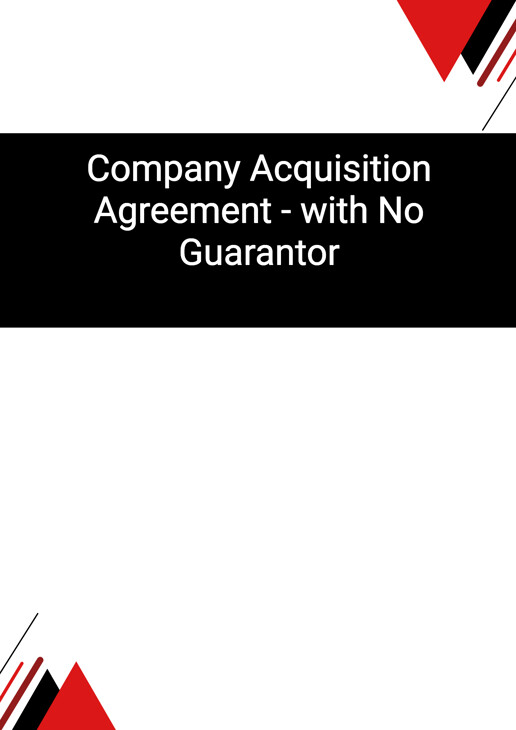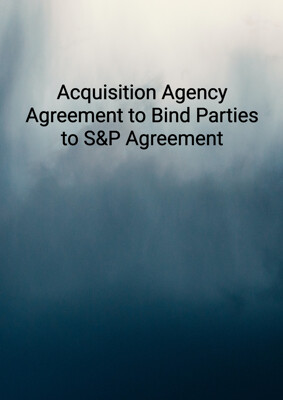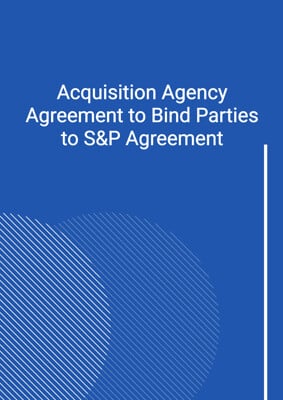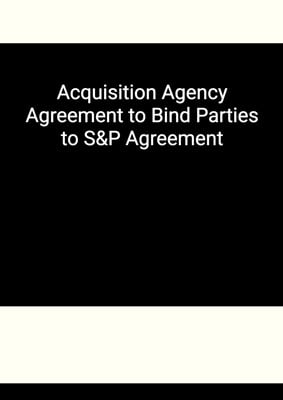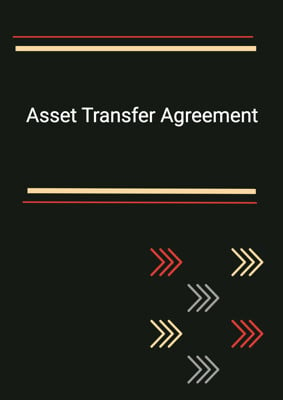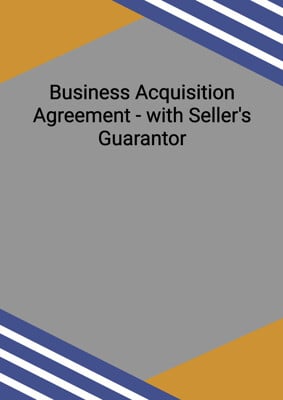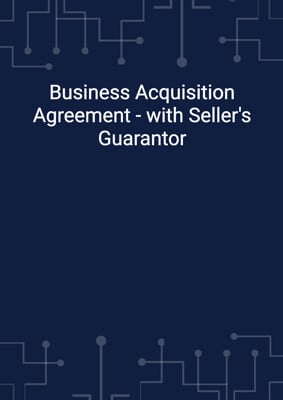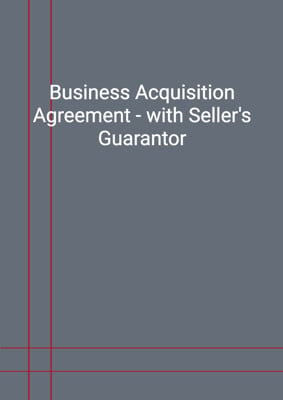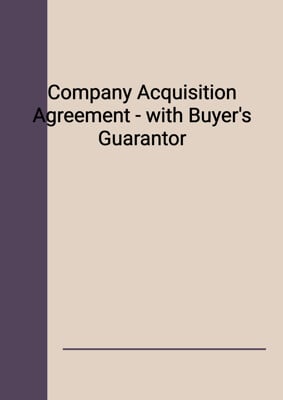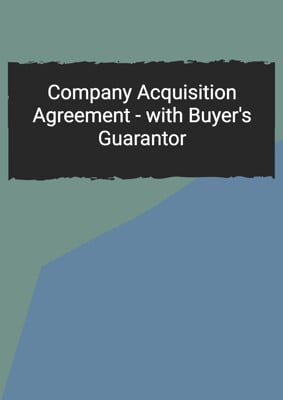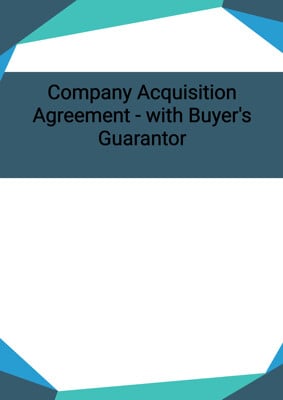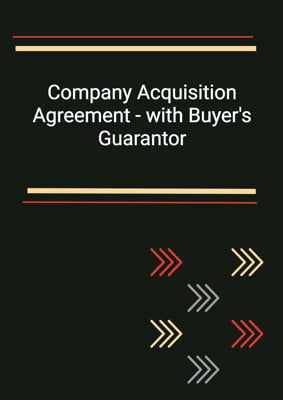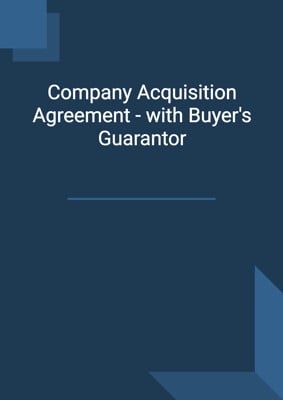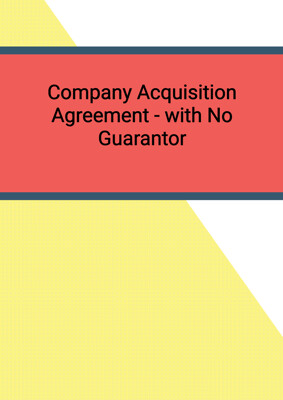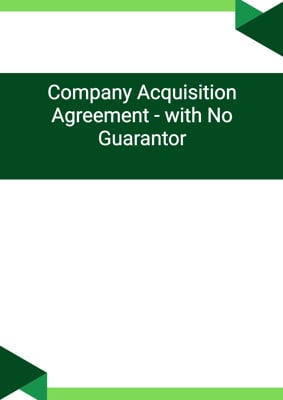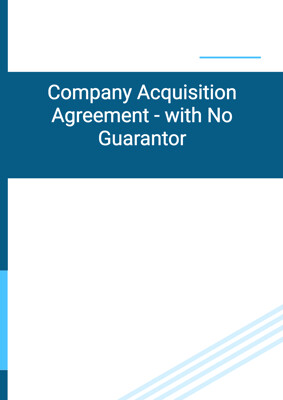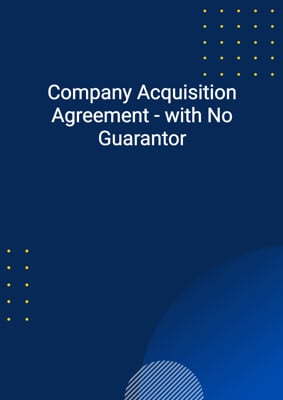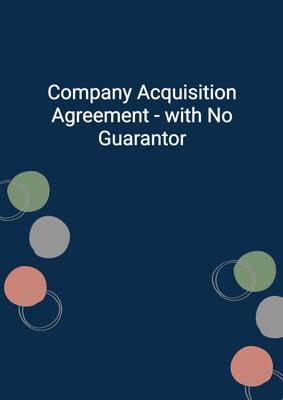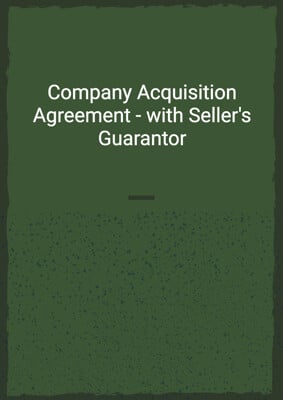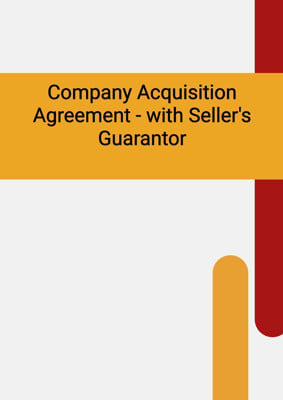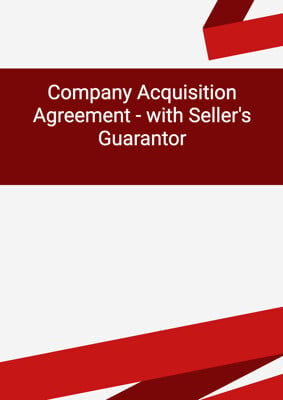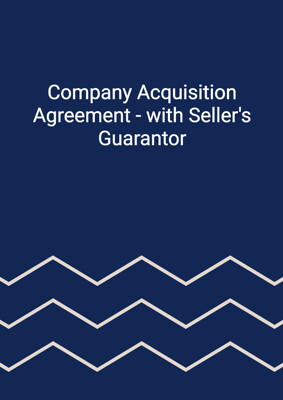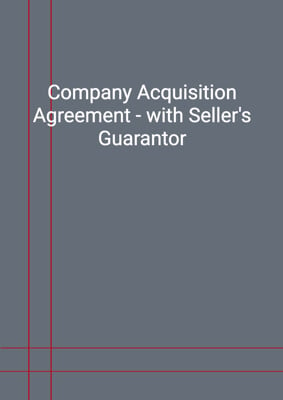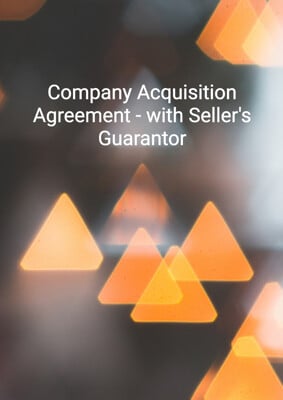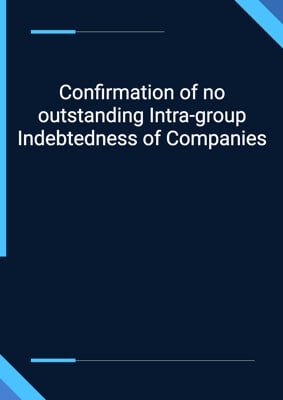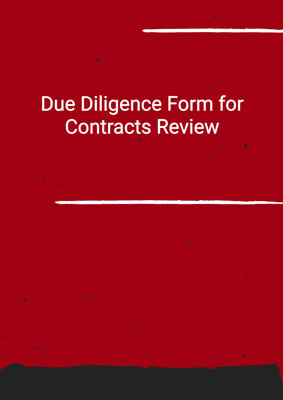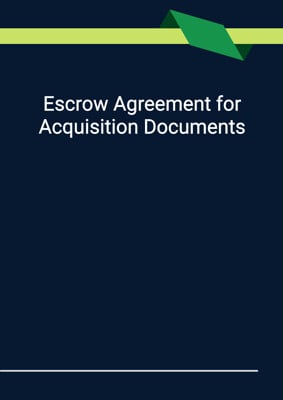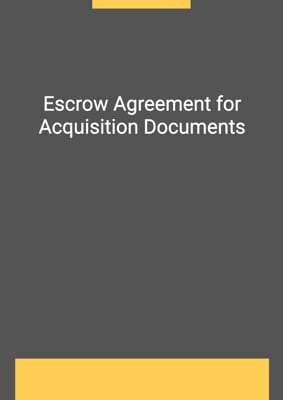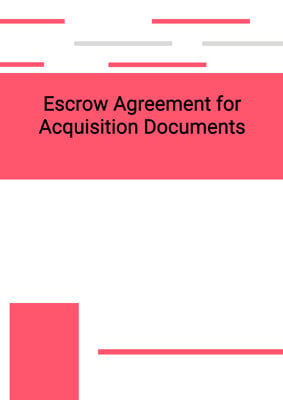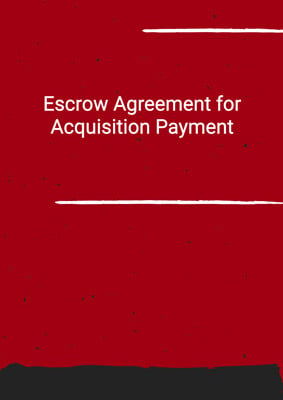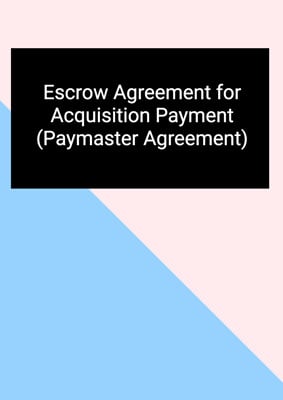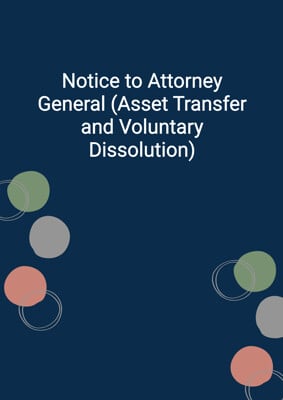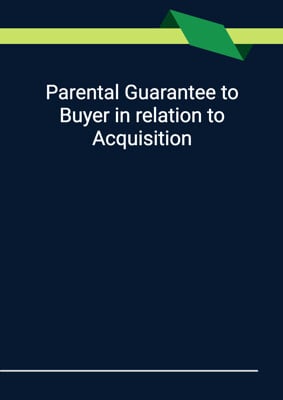How to Tailor the Document for Your Need?
01
Create Document
Fill in the details of the parties. You can click the "Fill with Member’s Information" button to complete it with information saved to your account.
02
Fill Information
Please fill in any additional information by following the step-by-step guide on the left hand side of the preview document and click the "Next" button.
03
Get Document
When you are done, click the "Get Document" button and you can download the document in Word or PDF format.
04
Review Document
Please get all parties to review the document carefully and make any final modifications to ensure that the details are correct before signing the document.
Document Preview
Document Description
The Company Acquisition Agreement - with No Guarantor is a legal document that outlines the terms and conditions of the acquisition of a company. The agreement is entered into between the sellers, who are the legal and beneficial owners of the share capital of the company, and the buyer, who wishes to purchase all of the issued share capital of the company. The agreement highlights the importance of the document by emphasizing the need for a clear understanding of the terms and conditions of the acquisition.
The entire document is divided into several sections, each of which serves a specific purpose. The first section, titled 'Interpretation', provides definitions for the key terms used throughout the agreement. This ensures that both parties have a clear understanding of the terms used in the document.
The second section, titled 'Sale of the Shares and Price', outlines the details of the sale and purchase of the shares. It specifies the number of shares to be sold by each seller and the agreed price to be paid by the buyer. The section also includes provisions for the payment of the price, whether in cash or shares, and the transfer of the shares to the buyer.
The third section, titled 'Conditions to Completion', sets out the conditions that must be fulfilled before the sale and purchase of the shares can be completed. These conditions include the passing of a resolution by the shareholders of the sellers approving the transaction, the delivery of written consents from relevant persons, and the repayment of any outstanding intra-group indebtedness.
The fourth section, titled 'Pre-Completion Undertakings', outlines the obligations of the sellers prior to completion. These obligations include conducting the business in the ordinary and usual course, preserving and protecting the business assets, allowing the buyer's representatives access to the books and records of the company, and making prompt disclosure of any relevant information.
The fifth section, titled 'Completion', sets out the process for completing the sale and purchase of the shares. It specifies the documents and certificates that must be delivered by the sellers to the buyer, including transfers of shares, share certificates, and statutory books. The section also includes provisions for the payment of the price and the allocation of consideration shares, if applicable.
The sixth section, titled 'Completion Accounts', outlines the requirements for preparing completion accounts. These accounts are prepared to determine the value of the net tangible assets of the company and the final purchase price. The section specifies the accounting policies and procedures to be followed in preparing the completion accounts and provides for the resolution of any disputes regarding the accounts.
The seventh section, titled 'Post-Completion Undertakings', sets out the obligations of the sellers following completion. These obligations include the repayment of connected trading indebtedness, the release of any connected guarantees, the change of the sellers' group company name, and the cessation of the use of trade secrets or confidential information.
The eighth section, titled 'Restrictions on the Sellers', imposes restrictions on the sellers' activities after completion. These restrictions include a prohibition on engaging in any competing business and soliciting or employing former employees of the group company.
The ninth section, titled 'Warranties', sets out the representations and warranties made by the sellers to the buyer. These warranties cover various aspects of the business, including its financial position, assets, liabilities, and intellectual property rights. The section also includes provisions for the sellers' liability in the event of a breach of warranty.
The tenth section, titled 'Limitations on Claims', sets out the limitations on the buyer's claims for breach of warranty. It specifies the procedures for making a claim and the maximum liability of the sellers under the warranties.
The eleventh section, titled 'Buyer's Rights to Terminate', gives the buyer the right to terminate the agreement in certain circumstances, such as a breach of the agreement or a material adverse change in the business.
The twelfth section, titled 'Withholding Tax and Grossing Up', addresses the tax implications of the agreement and specifies the obligations of the sellers in relation to tax deductions or withholdings.
The thirteenth section, titled 'Entire Agreement', states that the agreement and the disclosure letter constitute the entire agreement between the parties and supersede any prior agreements or arrangements.
The fourteenth section, titled 'Variation', specifies that any variation of the agreement must be in writing and signed by all parties.
The fifteenth section, titled 'Assignment', allows for the assignment of rights and obligations under the agreement, subject to certain conditions.
The sixteenth section, titled 'Announcements', restricts the parties from making any announcements or disclosures regarding the agreement without the prior written approval of the other party.
The seventeenth section, titled 'Costs', specifies that each party is responsible for its own costs incurred in connection with the agreement, except for certain specified costs.
The eighteenth section, titled 'Severability', provides that if any provision of the agreement is held to be invalid or unenforceable, it shall be deemed not to be included in the agreement, but the remaining provisions shall remain in full force and effect.
The nineteenth section, titled 'No Rights of Third Parties', states that only the parties to the agreement have the right to enforce its terms.
The twentieth section, titled 'Governing Law, Jurisdiction', specifies that the agreement is governed by the laws of the relevant jurisdiction and any disputes arising from the agreement shall be subject to the exclusive jurisdiction of the courts of that jurisdiction.
The twenty-first section, titled 'Notices and Service', sets out the requirements for giving notice under the agreement, including the methods of service and the addresses for service.
The twenty-second section, titled 'Waivers/Buyer's Rights and Remedies', specifies that the buyer's rights and remedies under the agreement are cumulative and may be exercised as often as necessary. It also states that the buyer's rights and remedies are not affected by completion, any investigation into the affairs of the group, the expiry of any limitation period, or any event or matter, except for a specific written waiver or release by the buyer.
The twenty-third section, titled 'No Rights of Third Parties', states that a person who is not a party to the agreement has no right to enforce its terms.
The twenty-fourth section, titled 'Governing Law, Jurisdiction', specifies that the agreement is governed by the laws of the relevant jurisdiction and any disputes arising from the agreement shall be subject to the exclusive jurisdiction of the courts of that jurisdiction.
The schedule sections provide additional details and information related to the agreement, such as the details of the company and its subsidiaries, the warranties, the completion accounts, the articles of association, and the pension scheme. These schedules provide further clarity and specificity to the terms and conditions of the agreement.
Overall, the Company Acquisition Agreement - with No Guarantor is a comprehensive and detailed document that covers all aspects of the acquisition process, ensuring that both parties have a clear understanding of their rights and obligations.
How to use this document?
To use the Company Acquisition Agreement - with No Guarantor, follow these steps:
1. Review the entire agreement to understand its purpose and the obligations of each party involved.
2. Ensure that all parties involved in the acquisition process have a clear understanding of the terms and conditions outlined in the agreement.
3. Before completion, fulfill the conditions specified in the agreement, such as obtaining shareholder approval and delivering written consents.
4. Prior to completion, comply with the pre-completion undertakings, including conducting the business in the ordinary and usual course, preserving and protecting the business assets, and allowing the buyer's representatives access to the books and records of the company.
5. Complete the sale and purchase of the shares at the designated location and time specified in the agreement.
6. Deliver the required documents and certificates, such as transfers of shares, share certificates, and statutory books, to the buyer.
7. Make the agreed-upon payment, whether in cash or shares, in accordance with the provisions of the agreement.
8. If applicable, prepare completion accounts to determine the value of the net tangible assets and finalize the purchase price.
9. Fulfill the post-completion undertakings, such as repaying connected trading indebtedness and releasing any connected guarantees.
10. Comply with the restrictions on the sellers, including refraining from engaging in any competing business and soliciting former employees of the group company.
11. Adhere to the warranties made in the agreement and address any claims or breaches that may arise.
12. If necessary, seek legal advice or consult with professionals to ensure compliance with the agreement and resolve any disputes.
Note: This guidance is provided for informational purposes only and should not be considered legal advice. It is recommended to consult with a legal professional when using or entering into any legal agreement.
Not the right document?
Don’t worry, we have thousands of documents for you to choose from:
